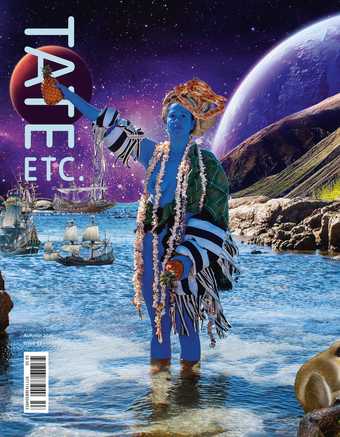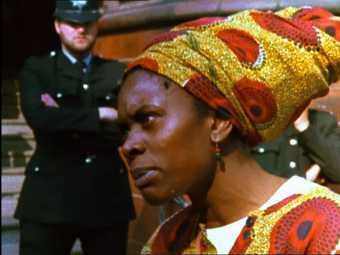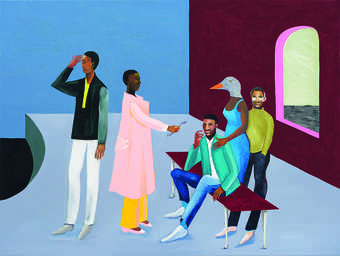
Lubaina Himid
Le Rodeur: The Lock 2016
Acrylic paint on canvas,183 × 244 cm
© Lubaina Himid. Private Collection, London. Courtesy the artist and Hollybush Gardens. Photo: Andy Keate
Lubaina Himid asks big questions – not just about history, race and gender, but also about the small things that impact on us on a daily basis, such as what you see when walking down the street or picking up a newspaper. She’s as interested in responding to the beauty and complexity of everyday encounters as she is in nurturing new, enriched ways of living; as open to the possibilities of sound as she is to the mixing of paint. Ever restless, the Zanzibar-born British artist, activist, curator and teacher creates exhibitions from paintings, flags, fabric, jelly moulds, theatre sets, printed matter, texts, music, spoken word and more; she’s also currently developing ideas for an opera with the art historian Griselda Pollock.
Much of her work looks and sounds joyous, even as it reflects upon terrible events. (More on this later.) I asked her to describe the thread that runs through her thinking. After a moment, she replied: ‘I’m presented with a horror or a trauma – one I’ve lived or remembered, or one I’m retelling or uncovering – and I try to find some damn way out of it. That’s how the work gets made.’ She elaborated: ‘When I dive into it, I have to struggle to find a way out and into the other side. There are always different conversations going on. Resolution and strategy are at the heart of almost everything I do.’
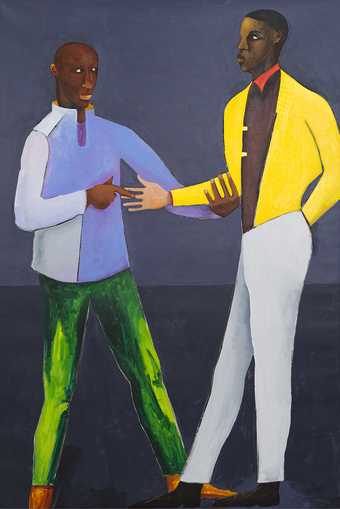
Lubaina Himid
Stir Until Melted (The Fortune Teller) 2020
Acrylic paint on canvas, 183 × 122 cm
© Lubaina Himid. Collection Van Valen, Aerdenhout, the Netherlands. Courtesy the artist and Hollybush Gardens. Photo: Gavin Renshaw
Her journey to becoming an artist was circuitous. In the 1970s, Himid trained as a theatre designer at the Wimbledon College of Art, but it wasn’t the right fit: she laughingly describes conventional theatre as ‘my idea of hell’. She joined a small theatre group run by friends, and found work sewing costumes at the Royal Opera House and waitressing in a brasserie in Covent Garden. She began observing ‘how people behave in a space’ and how an environment affects behaviour. The owner of the brasserie asked her to design its interior and she devised a ‘comfortable but plain’ dining room with artworks on the wall that she hoped might prompt a discussion. In thrall to Bertolt Brecht’s belief that theatre is a forum for political ideas, she realised that for her, ‘the magic is when you can see behind the scenes and see how something works, not the theatre of illusion’. She discovered that placing art next to someone eating was more exciting to her than staging a play. So she became an artist.
Himid was actively involved in the British Black Arts Movement of the 1980s and 1990s – an antiracist, feminist group of artists which included Sonia Boyce, Claudette Johnson, Rasheed Araeen, Donald Rodney and others. Alongside her art practice, she curated Five Black Women at the Africa Centre, Black Women Time Now at Battersea Arts Centre, and The Thin Black Line at the Institute of Contemporary Art in London, exhibitions that sought to redress the invisibility not only of the Black body in contemporary art but also the exclusion of women from the mainstream. In 1984, she completed a master’s degree in cultural history at the Royal College of Art; her thesis was ‘Young Black Artists in Britain Today’. In 1991, Himid moved to Preston. She is currently Professor of Contemporary Art at the University of Central Lancashire and leads the Making Histories Visible research project.
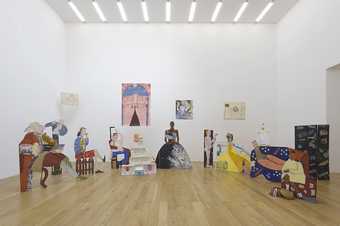
Lubaina Himid’s A Fashionable Marriage 1986–2017 installed at Nottingham Contemporary, 2017
© Lubaina Himid. Courtesy the artist and Hollybush Gardens. Photo © Nottingham © The National Gallery, London Contemporary. Photo: Andy Keate
Himid’s theatre training is apparent in both the importance she ascribes to storytelling and scenemaking, and in her attention to the structures and the architecture that contain and support her work; even her static images seem to leap off the walls and run amok. In 1984, she transposed the figures in Pablo Picasso’s 1922 painting Two Women Running on the Beach (The Race) into an exultant installation Freedom and Change: two Black women in patchwork dresses hold their entwined hands high as they dance joyfully across a pink sheet. One of them grasps the leads of four black dogs; to the left, two bald white men are buried up to their ears in the sand.
Two years later, Himid created the human-sized tableau A Fashionable Marriage 1986, a response to the work of the 18th-century artist William Hogarth. It’s a riotous installation of brightly painted, human-sized, cartoonlike figures, many of which are papered with words cut from scraps of newspaper, such as ‘apocalypse run’ and ‘backlash’. The work – which, along with the figures, includes wall hangings, painted boxes, texts, plates and more – is a riposte to Hogarth’s six-part satirical series Marriage A-la-Mode c.1743, a squalid tale of lust and greed that illustrates the consequences of marrying for money.
Himid was grappling with how to depict what she described as the ‘hedonistic, greedy, self-serving, go-getting opportunistic mayhem’ of London in the 1980s. She found her perfect ally in Hogarth because ‘he used the black person to expose the shady morals of the white main protagonists’. In Himid’s version, various characters jostle for attention, and she recasts Hogarth’s main players: the Countess has been replaced with a fragmented Margaret Thatcher, ‘champion of business, destroyer of the unions’; the ambassador, perched on a picket fence, is reborn as a ‘dithering art funder’; and the ‘slave servant’ becomes ‘a black woman artist with articulated arms and an elaborate dress’ who has ‘much to offer’.
As with all of Himid’s work, politics is visualised as an ongoing conversation with the present and the past – a conversation complicated and enhanced by the inclusion of the everyday; the choice of a plate or a piece of fabric is, for her, as significant as colour and line. (Her mother was a textile designer, and fabric, in various incarnations, recurs again and again in her work.) Yet, despite the serious cultural critique that beats at the heart of A Fashionable Marriage, it fizzes with humour. As the artist is always quick to make clear, power loathes laughter: it’s the one thing it can’t control.
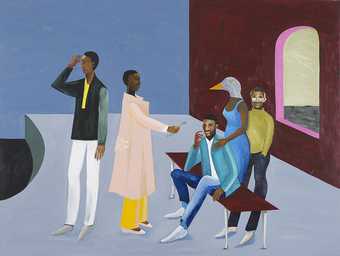
Lubaina Himid
Le Rodeur: The Exchange 2016
Acrylic paint on canvas, 183 × 244 cm
© Lubaina Himid. Courtesy the artist and Hollybush Gardens. Photo: Andy Keate
In the decades since A Fashionable Marriage, Himid has continued to explore issues around race, gender and class from myriad angles. Her monumental installation Naming the Money 2004 is a moving homage to the slaves and servants whose names might be lost but whose labour and skills contributed to Europe’s culture and economy. On the reverse of 100 life-sized, colourfully painted cutouts – of ceramicists, herbalists, toymakers, dog trainers, musicians, dancers, shoemakers, map makers and artists – a short fictional text that briefly imagines each character’s story is pasted onto an invoice; the story is also narrated on a soundtrack. ‘My name is Ngoba. They call me Sissie. I used to make counters to predict the future. Now I make dice for their games. But I can still see what’s coming.’ To name someone is to honour their individuality, to make clear that they had a life, a family – and that they’re so much more than a statistic.
Himid’s later series of paintings Le Rodeur 2016–17 – titled after the French slave ship of the same name – again reiterates that no life is easily represented, and each one lost is a tragedy of unspeakable proportions. In 1819, en route to Guadeloupe, 162 enslaved men, women and children went blind; the causes are unknown, but most likely it was an outbreak of ophthalmia. The captain had 36 people thrown overboard in order to claim the insurance. Himid translates this terrible – and, given the extent of the atrocity, unrepresentable – tale into a sequence of images in which she transposes the enslaved people’s lives to the present.

Lubaina Himid
Le Rodeur: The Pulley 2017
Acrylic paint on canvas, 183 × 244 cm
© Lubaina Himid. UK Government Art Collection. Courtesy the artist and Hollybush Gardens. Photo: Stephan Baumann
Set in rooms or on decks from which the sea – a site of both solace and horror – is visible in the distance, smartly dressed Black men and women are pictured in enigmatic groupings in which a ghostly sense of confusion hums like a threat. Two women turn away from each other beneath a pulley; a woman with a bird’s head supports a seated man, while another woman offers him a small piece of cloth. Beneath a mysterious sculptural lock affixed to a wall, a man in a pink suit holds his arms out to a woman on a yellow couch. The paintings are clear: individual lives are not grand narratives; they are formed of delicate connections and intimate languages. Each life has its secrets and each one of them is precious.
As well as exploring tragic histories with great sensitivity, Himid is adept at puncturing pomposity – be it individual or institutionalised – with humour and nuance. Her 2019 installation Work from Underneath, for example, comprises high-key paintings of tools and a sound-recording in which the artist reads, often in a near-whisper, from health and safety manuals: ‘keep moving parts lubricated’ to ‘provide adequate protection’ and ‘ensure sufficient slack’ – slogans which become captions for the paintings. Transformed into salacious, funny titbits, authority becomes the butt of a joke whose premise is deadly serious. Himid explained her rationale: ‘The British ruled the world with rules and regulations and part of the strategy of colonialism is controlling the world via catastrophising – laying on rule after rule and not crediting their subjects with common sense.’
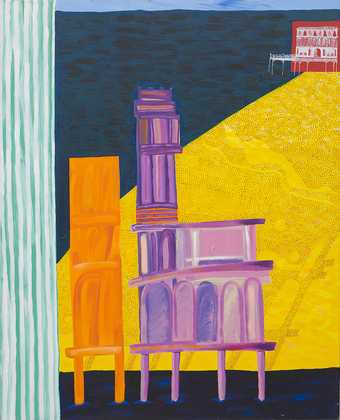
Lubaina Himid
Garfoni 1995
Acrylic paint on canvas, 153 × 122 cm
© Lubaina Himid. Courtesy the artist and Hollybush Gardens. Photo: Andy Keate
For her major exhibition at Tate Modern, Himid wants to energise, entertain and challenge each visitor; to make them feel that they’re ‘the most important person in the room’. (She told me she often returns to the last lines of Mary Oliver’s poem ‘The Summer Day’: ‘Tell me, what is it you plan to do / with your one wild and precious life?’) The result is a series of non-sequential spaces in which old work and new will coexist, linked by poems by writers including Audre Lorde and waves of sound that fade in and out like memories – from Zanzibarian celebratory music to Handel’s Queen of Sheba and newly commissioned work by Himid’s long-term collaborator, the artist and composer Magda Stawarska-Beavan.
The latter will include Blue Grid Test 2020, a hypnotically personal response to a deceptively simple query: ‘What does colour sound like?’ It’s just one of the many questions the artist has asked over the years, not only of the world, but also of herself. She’s currently working on a series of paintings in which she imagines the characters wondering: ‘What happens now?’ I suspect she’s less interested in a straightforward answer than in keeping the conversation alive.
Lubaina Himid, Tate Modern, 25 November 2021 – 3 July 2022. Curated by Michael Wellen, Curator, International Art and Amrita Dhallu, Assistant Curator, International Art, Tate Modern. Supported by John J. Studzinski CBE, with additional support from the Lubaina Himid Exhibition Supporters Circle, Tate Americas Foundation and Tate Patrons. Organised by Tate Modern in collaboration with Musée cantonal des Beaux-Arts de Lausanne/Plateforme 10.
Jennifer Higgie is a writer. Her new book on historic women’s self-portraits, The Mirror and the Palette, is published by Weidenfeld & Nicolson.

